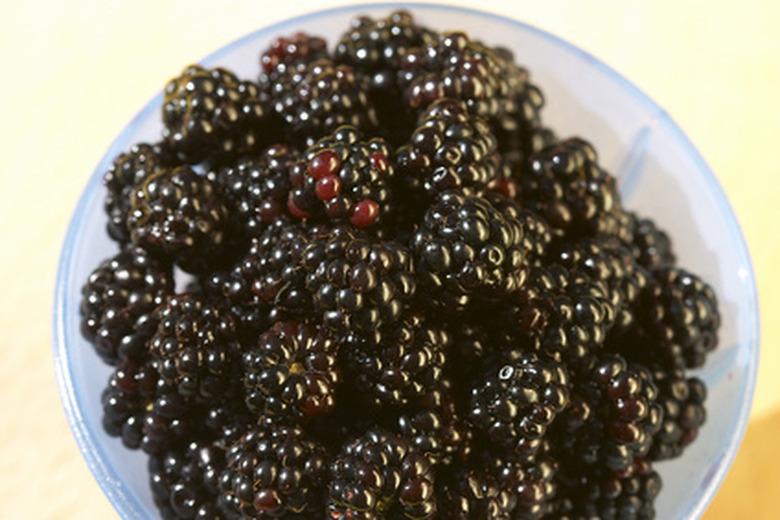How To Grow Blackberries In Texas
Things Needed
- Blackberry root cuttings or nursery plants
- Soil pH test kit
- Nitrogen fertilizer
- Pruning shears
- Fungicide
- Insecticide
Blackberries are fairly easy to grow and make a tasty addition to your Texas garden. They grow well in USDA plant hardiness zones 7 through 9. The best Texas blackberry harvests occur when the plants are three to eight years old, though with proper care they can continue producing for up to 15 years. Tasty right out of the garden or added to pies, blackberries are a great choice to add flavor to your garden.
Step 1
Choose a location with sandy or well-drained soil to plant your blackberries. Build a raised bed for your blackberry patch if your soil has poor drainage.
Step 2
Test the soil's pH; blackberries thrive in Texas soils with a pH between 4.5 and 7.5. If your soil's pH is below 4.5, raise the pH by adding lime. If the pH is above 7.5, add sulfur to make it more acidic and bring it within the correct range.
- Blackberries are fairly easy to grow and make a tasty addition to your Texas garden.
- If your soil's pH is below 4.5, raise the pH by adding lime.
Step 3
Plant root cuttings during the winter dormant season.
Step 4
Lay the root cuttings in a horizontal position two to four inches deep, two to three feet apart within the row, with rows eight to 12 feet apart. Blackberries planted from root cuttings will start producing in their second year.
Step 5
Plant blackberries purchased in nursery containers in early spring for best results.
Step 6
Give your blackberries a good watering when you're finished planting. Start watering established blackberry plants in March or April when the growing season begins, and stick to a regular schedule. During dry periods you may need to water at least once a week.
- Plant root cuttings during the winter dormant season.
- Start watering established blackberry plants in March or April when the growing season begins, and stick to a regular schedule.
Step 7
Start reducing the water you give your blackberries by September to slow their growth and to let the canes harden before winter.
Step 8
Fertilize your blackberries with nitrogen fertilizer only. Apply small amounts of nitrogen fertilizer on a frequent schedule, starting when the plants bloom
Step 9
Cut back the prima canes (non-fruiting canes produced in the first year) when they get 36 to 48 inches high to encourage them to form branches. Cut them back to a point just above where you see a bud for a new shoot forming.
Step 10
Cut the floricanes (fruiting canes produced in the second year and every year after) to the ground after the plants have finished producing for the season and the canes die.
Step 11
Mow your blackberry plants to ground level every three years. This removes any diseased wood that may be present.
- Start reducing the water you give your blackberries by September to slow their growth and to let the canes harden before winter.
Step 12
Remove all dead, cut or mowed plant debris and destroy it to prevent spreading diseases.
Step 13
Monitor your blackberries regularly for signs of diseases or pests and treat as needed with fungicides or insecticides.
Tip
Blackberry varieties that grow well in Texas include Brazos, which is good for cooking; Arapaho, a thornless, disease-resistant variety; Brison, which does well in south-central Texas or in clay soils; and Rosborough, a cultivar with a sweeter berry that does well in the eastern and south central portions of the state. Your blackberries will grow well in zones seven through nine; the extreme southeast portion of Texas and extreme northern tip of the panhandle are outside these zones. If you live in either of these areas your local conditions may prove unsuitable for blackberry planting.
Warning
Always read and follow label directions for fungicides and insecticides, for your safety and to prevent damage to the plants.
